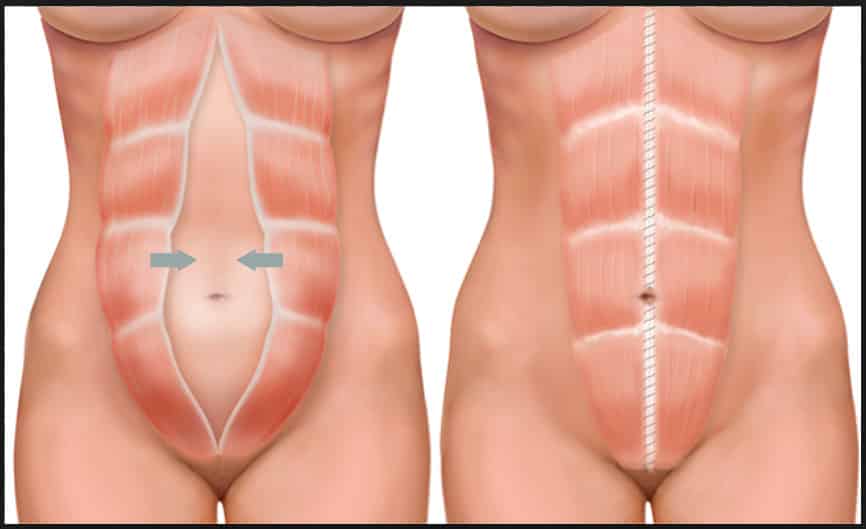Abdominal diastasis is a problem that affects many postpartum women, and the sooner it is diagnosed, the easier it becomes to treat.
What do you know about diastasis? Although the problem is more common than imagined, in most cases, many women don’t even know what they are going through. Known as abdominal diastasis, the problem consists of the separation of the abdominal muscles and connective tissue. It is normal for this to happen during pregnancy, justifying not only abdominal sagging, but also postpartum lower back pain.
Normally, the size of the gap in the abdomen caused by diastasis varies from 1 to 3 centimeters. This, however, depends on the woman’s body and the type of pregnancy she had. However, in more serious cases, the separation can reach up to 10cm, and the problem occurs due to weakness of the abdominal muscle. During pregnancy, it becomes very stretched as your belly grows. However, there are also other cases of abdominal diastasis, such as in people who lift very heavy objects, but incorrectly.
Although it is uncomfortable and causes more than just a physical impression on the abdomen, there are treatments to correct diastasis. In this sense, through exercises, physiotherapy and, as a last resort, surgery. Check below everything you need to know about diastasis, as well as the best ways to solve the problem.
What is diastasis?

The straight abdominal muscles are always in two and parallel, that is, lateral to each other. In the case of an increase in intra-abdominal pressure with the separation of these muscles, diastasis occurs. Its most common cause is pregnancy, but it can also occur due to lifting very heavy objects incorrectly, multiple pregnancies, malnutrition or obesity.
It is common for women who do not exercise and do not have a worked abdomen to be more likely to have diastasis. In this sense, hormones during pregnancy also contribute to the formation of the problem, that is, muscle relaxation. Certain factors such as obesity, multiple pregnancies, excess amniotic fluid and a large baby predispose a woman to abdominal diastasis.
How to find out the problem
First of all, it is possible to suspect if you have diastasis after giving birth, if the area below your navel feels very soft and flaccid. Likewise, when you squat, cough and lift weights and end up noticing a bulge in the abdomen, abdominal diastasis is identified.
It is possible to take the test at home. Lie on your back and press your middle and index fingers approximately 2cm below your navel. Then, contract your abdomen, almost as if you were going to do an abdominal exercise. In a common situation, when contracting the abdomen, the fingers will jump upwards, but in the case of diastasis, they do not move. In fact, it is even possible to place 3 or 4 fingers side by side, without them moving with the contraction.
In any case, in addition to the home test, it is essential to perform an ultrasound and also seek evaluation from a physiotherapist. If the gap is less than 4cm, physical exercises can treat the problem in up to 3 months. In more serious cases, surgery becomes necessary.
Treatment of abdominal diastasis
One of the simplest ways for more basic cases of abdominal diastasis is a good physical exercise routine, activating the core, but still safe. Furthermore, physiotherapy can also help a lot, and in a last case, surgery.
1 – Clinical pilates exercises

Despite being relatively easy to perform, it is crucial that exercises to treat diastasis are supervised by a physiotherapist or personal trainer. This happens because poor execution causes even more intra-abdominal pressure, increasing the separation of the recti and worsening diastasis. In more serious cases, it is possible to even develop a hernia.
The most recommended exercises are those that contract the transverse abdominis and the lower fibers of the rectus abdominis, making them stronger. But even so, such exercises do not cause excessive pressure on the rectus abdominis.
2 – Physiotherapy

During physiotherapy sessions, to treat diastasis, equipment such as FES is used, which promotes muscle contraction. In addition to being quick, lasting 15 or 20 minutes, it is also very efficient in strengthening the rectus abdominis.
3 – Diastasis surgery

As a last resort, to treat more serious situations, surgery is performed to correct the diastasis. Despite this, it is usually very simple, consisting of sewing the muscles together. Through a transverse cut in the lower abdomen, the tissue is removed to the level of the navel or above. Then, the muscles are brought together again with fixation by the aponeurosis. The surgery, in addition to being corrective, is also aesthetic. In this sense, the doctor may also suggest an abdominoplasty or liposuction to remove excess fat.
During treatment

While the problem of abdominal diastasis is being treated, there are other measures that can be taken to speed up the process. The habits are simple and anyone can adopt them, as most of them just make the belly hard.
- Always maintain good posture, both standing and sitting;
- Avoid bending your body forward, as if you were going to do a traditional sit-up. This can make diastasis worse;
- Whenever you need to pick up something from the floor, remember to squat, bending your legs, without leaning your body forward;
- Always keep your transverse abdominal muscle contracted. This habit is known as hypopressive abdominal pain, and you don’t need to do anything other than try to bring your navel closer to your back, keeping your belly tucked in even when sitting;
- Always use the postpartum belt, even to sleep, but still maintain the abdominal contraction exercise;
- When changing your baby’s diaper, avoid low surfaces, and if you need to change in bed, kneel down to avoid tilting your body.
Complications

The most common complication of abdominal diastasis is back pain, usually in the lower back. This happens because your abdominal muscles act as a natural brace while you walk, sit and exercise, protecting your spine. In the case of a weak muscle, the spine is overloaded, with a greater risk of even developing a herniated disc. Therefore, treatment is essential, as it is not simply aesthetic.
Duration of diastasis treatment
When treating diastasis, everything will depend on its size, since the greater the spacing, the more difficult it will be to unite the fibers with exercise and physiotherapy alone. However, in cases with a spacing of less than 5cm, with daily treatment, it is possible to observe a reduction in the problem in 2 or 3 months. When reaching 2cm, it is now possible to use isotonic exercises, and from then on the evolution is increasingly faster.
If you are interested in this article about diastasis, take the opportunity to check out Vacuum: what it is, benefits, results and how to do it
Sources: Tua Saúde, Torcedores, Mãe Que Ama, Metrópoles, Faculdade de São Paulo
Images: Movement and Health, Ividoa, Instituto4Life, Folha Vitória, Central da Saúde, Very Chique, Blog Pilates

Sign up for our newsletter and stay up to date with exclusive news
that can transform your routine!
Warning: Undefined array key "title" in /home/storelat/public_html/wp-content/plugins/link-whisper-premium/templates/frontend/related-posts.php on line 12
Warning: Undefined array key "title_tag" in /home/storelat/public_html/wp-content/plugins/link-whisper-premium/templates/frontend/related-posts.php on line 13




